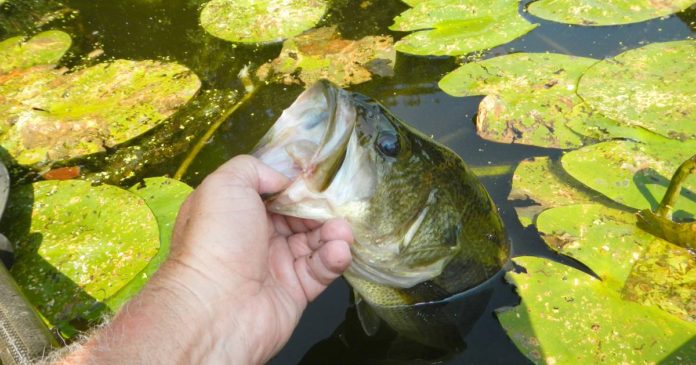A few weeks ago in Part 1, we covered fishing lily pads, spatterdock and emergent weeds. Here are more options for shallow water success in summer.
Duckweed is a tiny 1/16 to 1/8 inch light green weed that floats in dense mats upon many local waters. It provides food for several species of fish and other creatures and provides cool, oxygenated cover for baitfish and gamefish. Unlike pad fields, duckweed mats are thin allowing bass, pickerel and other gamefish to track lure movement across the mats and successfully take whatever is making the movement.
Duckweed draws fish. Several years ago, Joe Bruce and I were fishing a narrow section of Big Mill pond. I had some duckweed patches on my side and was taking fish from them. On the other side, Joe fished a usually productive shady cove but had no action. But, when he returned to this spot several hours later a mat of duckweed had blown in and Joe took bass after bass. We both concluded the bass had migrated to the area along with the duckweed.
A floating frog worked slowly in pauses is the lure of choice. Strikes are usually explosive and you may hook up only about half the time, but it’s sure exciting. Even the wrong lure can work. Using the Tiny Torpedo, the bass just struck this moving ball of weed.
If one piece of cover is good, more can be better. On one trip to Big Mill, I could only — and always — take bass that were in three kinds of cover: in the shade, under duckweed and under shoreline fallen trees.
Shade is one form of cover. Look for trees and shrubbery overhanging the water, boats, bridges, boat docks, etc. In streams and rivers, overhanging banks can be a sure thing, especially for brown trout. I’ve caught brown trout in Utah’s Green River and Virginia’s Jackson River that almost seemed to come from shore.
I have had outstanding days fishing the surface at the first light of morning, then seeing action suddenly stop when the sun was fully round on the horizon. I’ve seen this pattern bass fishing from shore in Liberty Reservoir, wading and by boat in Back Bay in Virginia, by boat in Susquehanna Flats and with stripers in Baltimore Harbor.
Carroll County Daily Headlines
Daily
Get the day’s top news and sports headlines.
Perhaps the most dramatic episode demonstrating this was the time I persuaded Harry Pippin to fish Baltimore Harbor early. In the brief period before sunrise, he caught several good stripers including two 10-plus pounds on a popper.
Cloud cover can extend the morning bite. On our last day of great surface fishing for bass in Virginia’s Back Bay, Scott Sparrow and I had fast surface action from pre-light until after 9 a.m. Finally, those heavy clouds let loose the rain and ended the activity.
This process can be reversed in the evening. When I used to fish Liberty Reservoir from shore in summer, I could usually count on taking two or three decent largemouth and/or smallmouths between roughly 8-9 p.m. At full dark, action ceased.
Night fishing is often touted but misunderstood. Often when full darkness sets in fishing activity ceases for about an hour before — or if — it resumes. In my experience, the best “night fishing” is darkness before the first morning light, i.e., pre-dawn. There are exceptions: One night I left well after dark in Deer Creek with hickory shad still hitting on every other cast.
I’ve had success with multiple species and across the country fishing at night with lights on the water. In Washington state, I took bass on a black popper in a log pond. In Texas, I took redfish and jacks on small jigs under pier lights. In Centennial Park, I still take bluegills on fly rod popping bugs under the ambient light from the athletic fields.
A favorite example was fishing in Baltimore Harbor. Joe Bruce and I fished big fly rod streamers along the light lines created by lights from anchored ships. We could see our streamers swimming along the edge of the light line, then see stripers rising from the shadows to take the flies.
Much of the above advice also applies to panfish, e.g., crappies at Liberty Reservoir and bluegills at Centennial Park Lake. In both fresh and salt water, shady cover has produced white perch. When Harry Pippin and I fished Wye River one sunny day, we took white perch on spinner-jig-grubs under every pier providing shade.
Credit: Source link































